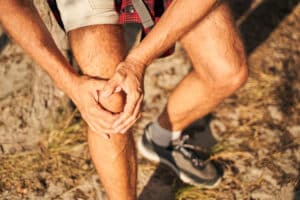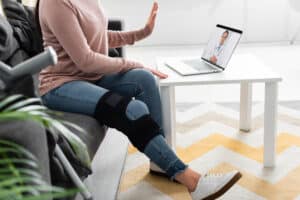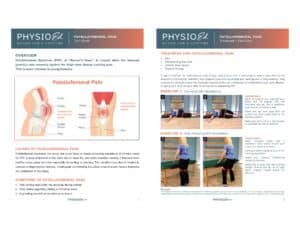Have you ever felt pain or discomfort in your knee when you bend it? Or maybe a dull ache that lingers after you straighten it? If so, don’t panic just yet!
Knee pain when bending is a common challenge for older adults, and it can have various causes. While it can be significant in some cases, it’s often very manageable and treatable.
Fortunately, many solutions for knee pain when bending can help reduce discomfort and improve mobility. As a physical therapist with plenty of training and experience helping older adults manage knee pain when bending, I will share some solutions with you here.
In this article, we’ll cover some common causes of knee pain when bending, how to limit pain when bending, and some tips on improving knee health in the long term.
Causes of Knee Pain When Bending

Without a doubt, knee pain when bending is a common complaint among older adults that can affect your daily activities. In fact, according to American Family Physician, nearly 25% of adults experience knee pain, accounting for 4 million primary care visits annually.1
Your knee allows you to bend and straighten your lower leg, enabling you to walk, kneel, and squat. As a result, your knee is essential in many fun activities you enjoy at home and out in the world.
When you bend your knee, you pressure the joint and its components. Typically, this pressure is distributed evenly and doesn’t cause any problems.
However, suppose the joint or its components are damaged or irritated. In that case, the pressure can cause pain and discomfort when you move.
The Five Most Common Causes of Knee Pain When Bending
Many different conditions can cause knee pain when bending for older adults. Let’s cover a few of the most common examples here and now.
Osteoarthritis
Osteoarthritis is a degenerative condition that occurs when the cartilage in the joint wears down over time, causing the bones to rub against each other.
This can lead to pain, stiffness, swelling, and reduced range of motion.2
Patellofemoral Pain Syndrome
Also called PFPS, patellofemoral pain syndrome is a condition that affects the kneecap (patella) and the groove in the thigh bone (femur) where it slides.
With PFPS, the patella often becomes misaligned or irritated, causing pain in the front of the knee, especially when bending and squatting.
Baker’s Cyst
In its most basic form, a Baker’s cyst is a fluid-filled sac that forms in the back of your knee, usually without a specific cause.
Although less common than other conditions, forming a Baker’s cyst can lead to discomfort and restricted knee motion. While specific exercises can be helpful for Baker’s cysts, they’re often treated by draining out the fluid or steroid injections.
Bursitis
Bursitis is a condition that occurs when the knee’s cushioning sacs (bursae) become inflamed, usually due to repeated irritation. This can cause pain, swelling, and redness in the knee. Bursitis can affect any of the bursae in the knee. Still, the most common are:
- The prepatellar bursa (in front of the kneecap).
- The infrapatellar bursa (below the kneecap).
- The pes anserine bursa (on the inner side of the knee).
Tendonitis
Tendonitis is the most common condition on this list. It occurs when the tendons in the knee become inflamed, usually due to overuse.
This can cause pain, tenderness, and stiffness in the knee. Most often, tendonitis affects the quadriceps tendon (above the kneecap), the patellar tendon (below the kneecap), and the iliotibial band (on the outer side of the knee).
I’ve seen older adults experience knee pain when bending due to each of these conditions, and many of them can be improved with proper self-care and treatment.
So, what should you do about it?
Solutions for Knee Pain When Bending
If you have knee pain when bending, kneeling, or squatting, you might be tempted to avoid bending your knee altogether. However, finding a balance between resting and moving your knee is a big part of improving your condition.
Here are some of the best first-line solutions for knee pain that I often recommend to my patients with new knee pain when bending:
Rest, then start moving again
Injuries can be acute, subacute, or chronic. In the acute stage, you should avoid activities that put too much stress on your knee, such as running, jumping, squatting, or kneeling. However, during the subacute stage, you should plan to start moving your knee again within your comfort zone.
With exercise, aim for a moderate level of activity that does not cause or increase your pain.3
Apply ice or heat to reduce inflammation and pain
Ice can help reduce swelling and inflammation, while heat can help relax the muscles and improve blood flow. You can apply ice or heat for 15 to 20 minutes at a time, several times daily, as needed.
Take over-the-counter pain relievers or anti-inflammatory drugs as needed
When used in short bouts, medications such as ibuprofen, naproxen, or acetaminophen can help relieve knee pain when bending. These drugs can reduce inflammation and pain and make it easier for you to move your knee.
However, you should always follow the dosage and instructions on the label and consult with your doctor before taking any new medications.
Wear a knee brace or sleeve
A brace or sleeve can help support your knee joint when walking, bending, kneeling, or squatting. Different types and equipment sizes are available depending on your needs, so don’t be afraid to ask an expert for advice.4
In my experience working with older adults who have new knee pain when bending, a combination of the above strategies can be beneficial in reducing symptoms and starting the recovery process.
However, your body is unique and may not respond the same way. For this reason, you should always consult with your doctor or physical therapist before starting any treatment or exercise program.
Neenca Compression Knee Sleeve
If you have a nagging knee pain that you want to protect from getting worse, you may benefit from wearing a compression brace with lateral support. This type of brace can reduce inflammation, improve blood flow, and provide some stability for your knee. Just remember this is a “comfort fix”, not a long-term solution. You’ll still want to follow up with your physical therapist for exercises and other therapies that can help you manage your pain and prevent further damage to your knee.
The highly rated Neenca Compression Knee Sleeve is the brace we most often recommend to our patients.
Our recommendations are the same items we trust and prescribe to patients. When you buy through links like this on our site, we may earn an affiliate commission to support new content.
Exercises and Stretches for Knee Pain When Bending
One of the best solutions for knee pain when bending is to do exercises and stretches that can help improve your knee mobility, strength, and flexibility. These exercises and stretches can help reduce pain and stiffness, and I regularly recommend many of them to my patients.
However, consult your physical therapist if you need help building an exercise program. Physical therapists are movement experts who can help you design a personalized and safe plan that suits your needs, teach you how to perform each exercise correctly and safely, and monitor your progress.
Quadriceps Stretches
The quadriceps are the muscles in the front of your thigh that help you straighten your knee. Stretching these muscles can help improve your knee flexibility and range of motion during bending, helping prevent tightness and soreness.
Standing Quadriceps Stretch
The lying quadriceps stretch is one of the easiest and most effective quadriceps stretches.
- To do this exercise, stand up with one hand on the back of a chair and place the same side knee on the chair seat.
- Step the opposite forward slightly and lean into the stretch on the front of the left thigh.
- You should feel a gentle stretch in the front of your thigh.
- Hold this stretch for 15 to 30 seconds, then switch legs and repeat.
Aim for a few sets with each leg. Depending on your preference, balance, and comfort, you can also stretch while sitting, standing, or lying on your belly.
Lower Body Strength Movements
Let’s start with the muscles that help you bend your knee.
The hamstrings are the muscles in the back of your thigh that help you bend your knee. Strengthening these muscles can help support and stabilize your knee joint, reducing stress during bending activities.
Knee Curl
The knee curl is one of the simplest and most effective hamstring-strengthening exercises.
- To do this exercise, lie on your stomach with both legs straight.
- Tighten the muscles in the back of your target leg and bend your knee to reach toward your bottom.
- Hold this position for a moment, then return slowly and repeat.
- Aim for 10 to 15 repetitions on each leg, then increase the number of reps as you get stronger.
- You can add some weight to your ankle or use a resistance band to make it more challenging.
Calf Raises
The calves are the muscles in the back of your lower leg that help you push off the ground and balance your body. Strengthening these muscles can improve knee stability and function and reduce the risk of injury and pain during bending.
One of the simplest and most effective calf-strengthening exercises is the calf raise.
- Stand with your feet shoulder-width apart and hold onto a wall, chair, or railing for support.
- From there, lift your heels off the floor and rise onto your toes, squeezing your calf muscles.
- Hold this position momentarily, then slowly lower your heels and repeat.
- Start with 10 to 20 repetitions, then increase the number of reps as you get stronger.
You can also do this exercise on one leg at a time or on a step or a block to increase the challenge.
Squats and Lunges
Squats and lunges are some of the most functional exercises for your lower body. They work multiple muscles and joints, including your knees, hips, and ankles.
To do a squat:
- Stand with your feet hip-width apart and keep your chest up.
- Bend your knees and hips to lower your body as if sitting on a chair, keeping your knees aligned with your toes.
- Go as low as you can, or until your thighs are parallel to the floor, and then push yourself back up to the starting position.
To do a lunge:
- Stand with your feet together and take a big step forward with one leg.
- Bend both knees and lower your body as far as you can comfortably, or until your front thigh is parallel to the floor and your back knee almost touches the floor.
- Push yourself back up to the starting position, then repeat.
- Note: As Trudy is doing in the video, it’s wise to use a chair for added balance support.
Start with 10 to 15 repetitions for each exercise and increase as you get stronger. You can also hold some weight in your hands or use a resistance band to make them more challenging.
For most people, having a short list of 3-5 exercises that feel good and help you get stronger is more than enough to make progress with knee pain. However, if you’re determined to push your fitness to the max, you can expand your exercise routine as big as you like!
Tips for Maintaining and Improving Knee Health from A Physical Therapist
Improving your knee health is not a one-and-done thing but a long-term commitment to your health that requires ongoing effort. While everyone’s health journey will be unique, there are a few tips that you can follow to optimize your knee health over time.
Move Throughout Your Day
One of the best things you can do for your knee health is to stay active and move throughout your day. Sitting or standing for long periods can cause your knee joint to stiffen and weaken, increasing your risk of pain and injury.
Break up your sedentary time by moving around every 30 minutes and doing some stretches or exercises for your knee.
Maintain a Healthy Weight
Maintaining a healthy weight can help reduce stress on your knee. Try to maintain a body mass index (BMI) appropriate for your height and age. Talk to your doctor if you don’t understand BMI or how to calculate your own.
Wear Comfortable, Supportive Shoes
Wearing comfortable and supportive shoes can help your posture and reduce knee stress during bending. Wear shoes that you like, and that fit your feet well and avoid shoes that are too tight or flat.
Knee pain isn’t always simple, but by combining the management techniques, exercises, and wellness strategies that work well for your body, you can make significant strides with your knee pain when bending for a more comfortable lifestyle.
Key Takeaways
- Knee pain when bending is common among older adults but is often manageable with proper care.
- Causes of knee pain include osteoarthritis, patellofemoral pain syndrome, Baker’s cyst, bursitis, and tendonitis.
- Initial solutions for knee pain include rest, application of ice or heat, over-the-counter pain relievers, and using a knee brace or sleeve.
- Exercises and stretches, such as quadriceps stretches, knee curls, calf raises, squats, and lunges, can improve knee mobility, strength, and flexibility.
- Maintaining a healthy lifestyle through regular movement, weight management, and wearing supportive shoes can help improve and maintain knee health.
FAQs
What are the common causes of knee pain when bending?
Knee pain when bending can result from several conditions, including osteoarthritis, patellofemoral pain syndrome, Baker’s cyst, bursitis, and tendonitis. These conditions affect the joint, surrounding tissues, or tendons, leading to discomfort, swelling, and stiffness during movement.
How can I relieve knee pain when bending?
To alleviate knee pain, rest the affected area, apply ice or heat, and consider taking over-the-counter anti-inflammatory medications. Using a knee brace or compression sleeve can also provide support. It’s essential to consult a doctor or physical therapist for personalized advice on managing pain and rehabilitation.
Are there exercises I can do to reduce knee pain when bending?
Specific exercises and stretches can help improve knee mobility, strength, and flexibility. Examples include quadriceps stretches and hamstring-strengthening exercises like knee curls, calf raises, squats, and lunges. Always consult a physical therapist to ensure you perform these exercises safely and effectively.
Should I avoid bending my knee if I experience pain?
While resting your knee initially is essential, avoiding all movement is not recommended. Gradual, moderate exercise can improve flexibility, strengthen the muscles around your knee, and reduce pain. Consult a healthcare provider to determine the appropriate balance between rest and movement for your condition.
What can I do to maintain long-term knee health?
To promote long-term knee health, stay active throughout the day, maintain a healthy weight, wear supportive shoes, and incorporate strength and flexibility exercises into your routine. Regularly moving, maintaining a healthy BMI, and supporting your joints can help prevent knee pain and enhance mobility.
References
- “Knee Pain in Adults and Adolescents: The Initial Evaluation.” American Family Physician.
- “Osteoarthritis”. Centers for Disease Control and Prevention.
- “Rest: A Health-Related Phenomenon and Concept in Caring Science.” Glob Qual Nurs Res. 2015 Apr 29;2:2333393615583663. doi: 10.1177/2333393615583663. PMID: 28462307; PMCID: PMC5342845.
- “EFFECTS OF A SEMI-RIGID KNEE BRACE ON MOBILITY AND PAIN IN PEOPLE WITH KNEE OSTEOARTHRITIS.” J Rehabil Med Clin Commun. 2022 Jul 5;5:2483. doi: 10.2340/jrmcc.v5.2483. PMID: 35859691; PMCID: PMC9274778.









